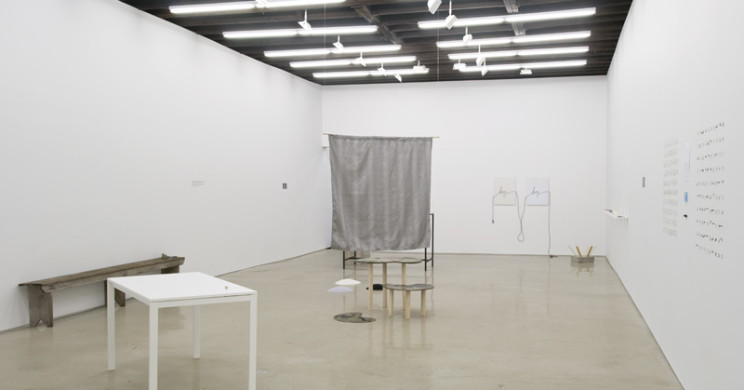In the past half hour, chances are you’ve noticed something about sound—friends interrupting each other, cell reception breaking up, a noise you thought came from your home that in fact came from the apartment below. There are a lot of strange things happening in our sonic universes. But what happens when you render sound tangible? What does transposing sound from its original object to another do to our perception? What are ways in which we approach noise as a layer of reality we can manipulate, whether to bolster productivity or to simply play around?
What’s unique about The String and the Mirror is its focus: unlike the survey of the field of sound currently on view at the MoMA, the 19 artists in this show are more interested in relationships than form, and in transmutations or tangents rather than technology. The artists were chosen by Justin Luke, director of Audio Visual Arts, and Lawrence Kumpf, who curates Issue Project Room.
The String and the Mirror is an exhibition that explores and purposefully tangles our relationships with sound. Lenticular prints, raw record vinyl piles, arranged bamboo, decibel meters, an audio cable diptych spelling out hey, and stones conversing are a few of the objects employed to accomplish this goal.
Artists pushed various aspects of sound into the tangible, creating what was largely a visual experience. How do you make the aural into a physical object? Data sonification is one way, seen here in Lawrence Abu Hamdan’s Conflicted Phonemes. In this project Hamdan creates a visual to complicate our notion of how languages in a country—particularly one with as troubled a background as Somalia’s—can change and torque over time. While many of the works in this show have a playful tone, Conflicting Phonemes hits a little harder. Here the artist creates a complex voice map that is at first difficult to fully comprehend. The goal: to work toward understanding the controversial use of language analysis employed by the government to determine the origin of asylum seekers. Hamdan’s voice maps act as offerings to the asylum seeker as “alternative and non-vocal mode of contestation.”
One example of how are relationships with noise are snarled is Two Stones Singing, a concise piece by Rolf Julias that used electronics to displace sounds found in nature—in a forest field, to be exact—and appropriated them to two stones. Rocks represent nature to us, yet it bends the mind to hear this information rather than to register it through thought.
Another piece makes suggestions for experiencing sound. Four proposals are printed on the wall below titles. Spencer Yeh, the artist, calls these Bad Ideas for a Sound Mind. To me these pieces are about reducing the irreducible—recording a noise and then reintroducing the noise to its origin, as in the idea below:
One Hundred Dollar Bills
One hundred $1 bills are buried under
a ceramic tile floor. Participants are
encouraged to treasure-hunt these with
contact mic’d dentist drills, but must wear
headphones playing the sound from the
drills while doing so.
Another striking piece was one hundred circles for the mind by Seth Cluett. This was framed as a repeatable experiment meant for propagation, with instructions and a list of materials. Sound here is a tangible object made to mimic the drawn circles. Cluett recorded himself drawing one hundred circles on separate pieces of paper and then listened to the recording. He removed the cassette tape from the tape housing, sliced it into 100 pieces, and carefully placed these pieces in a grid on the wall next to the circles on 100 pieces of paper. So, we have the sound of these circles’ conception mirroring the circles themselves.
At the back of the main gallery space there is a second room containing an ongoing interactive installation. This is Office Riddim, created by the New York-based duo Essex Olivares. Surprisingly, it’s an office with all the familiar objects in it that identify it to be so: paper, filing cabinets, a desk, plants, desk chairs, a water cooler. Other elements indicate that this is an office meant to destabilize the traditional, sterile office ambience, such as a bench with soft grey fur and a distorted ‘smile you’re on camera sign.’ A television records the room in real time.
“We have created a system,” a paper on the wall says. “A system that responds to you,” says another. “Release your mind, feel the present,” says a third. Other instructions, which you’re meant to do with a partner, urge you to “line the perimeter of your body with binder clips. Divide yourself in half.” It’s strangely relaxing being in someone else’s office. There’s a freedom in being asked to stuff your pockets with paper clips. Another suggestion reads, “lace an extension cord through the other user’s chair. Keeping both ends of the cord in hand, take a seat on the table.” The duo intended this work to examine how musical scores relate to start-up companies.
The overall effect of The String and the Mirror is the feeling of tension between aural stimuli and the way they are translated from oral to visual. There’s a kind of slippage that happens when your expectations are denied, and this slippage can often be the most pleasurable part of the experience. Altogether this show is an elegant and interrogative push for reexamining our experiential world through sound.
By Maria Anderson
























